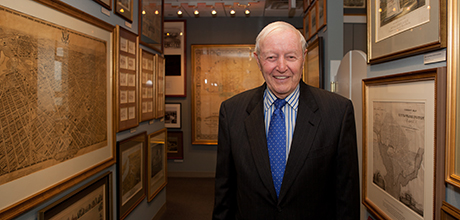The letter wasn’t something Albert H. Small had tracked for years, like some of the pieces that make up his extensive collection of Washington, D.C.-related, historical items. It wasn’t a long-sought prize. Indeed, Mr. Small hadn’t been aware that the 220-year-old letter—from President George Washington to City Commissioner David Stuart—existed before a few weeks ago.
But when he saw it in an auction catalog published by Christie’s, his collector’s instinct kicked in. He knew it would be a significant addition to his Washingtoniana Collection, which he donated to George Washington University in 2011.
“It came out of the clear blue sky, so to speak,” Mr. Small said. “It came out in the Christie’s auction catalog, and I get two or three catalogs five or six days a week. There are always things that come up that are interesting to a person like me.”
The letter had been owned by a private collector in New York and wasn’t publicly displayed, which is why Mr. Small and other collectors hadn’t been aware of its existence. But it was a perfect fit for his collection, which includes maps, drawings, letters, documents, lithographs and books relating to the history and evolution of the city of Washington and the nation’s capital, all collected over a period of more than 60 years.
“Have you yet decided on a plan for the capitol?” President Washington inquired of Commissioner Stuart in the letter, dated Nov. 30, 1792. “Is anything done towards the foundation of the president’s house?”
Also in the letter, President Washington inquires about who might serve as the chief architect of the planned federal city if not Pierre L’Enfant, who Washington had fired in February of that year for insubordination. He considers rehiring L’Enfant, as well as muses on other candidates for the role, including a candidate favored by Thomas Jefferson.
Washington writes that he wants “a man of fertile genius and comprehensive ideas…one who shall always reside here…a man of skill and judgment….But where, you may ask, is the character to be found who possesses these qualifications? I frankly answer I know not! Major L’Enfant …if he could have been restrained within proper bounds and his temper less untoward, is the only person with whose turn to matters of this sort I am acquainted, that I think fit for it.”
The letter is particularly historically significant because it highlights in a very frank manner that L’Enfant was a contentious figure, Mr. Small explained.
“He was controversial,” he said. “That’s part of the reason George Washington in this letter [discusses] controversy about him. It’s part of the essence of the letter.”
Mr. Small relayed an anecdote from another letter from Washington in which the president described how L’Enfant ordered a house torn down because it was in the way of one of the intersections for his planned grid system of streets.
The business of bidding at auction on artifacts like the Washington letter is not for the faint of heart, Mr. Small said. To purchase the letter, he called into the auction rather than travel to Christie’s in New York.
“You have to have a strong heart. That’s why I don’t go,” Mr. Small said, smiling. “It’s unnerving when you go and really want to get something, and you’re not sure who else is going to be there. I was on the phone [on Dec. 7] and I heard the bidders. I’ve been to enough auctions to know what the high limit might be. I had a pretty good feel for it. It’s a good letter.”
GW trustee Robert G. Perry, B.S. ’70, chairman and president of the National Trust for the Humanities, said the university couldn’t ask for more than Mr. Small’s passion in securing important primary documents like the Washington letter for the George Washington University Museum.
“GW is enormously fortunate to have such a knowledgeable and passionate collector and benefactor as we have in Albert Small,” Mr. Perry said. “His most recent purchase for us is such a brilliant example of his dedication to excellence.”
Mr. Small, a third-generation Washingtonian, is president of Southern Engineering Corporation. Currently housed in his office at Southern Engineering and at his home, the Albert H. Small Washingtoniana Collection will eventually reside in the new museum on the Foggy Bottom Campus, in the restored Woodhull House, where it will be accessible to students, scholars and the public.
When Mr. Small initially donated his collection to the university in February 2011, George Washington President Steven Knapp said it would provide “unparalleled opportunities not only for our current students and scholars but also for future generations to study the history of our nation through the study of this nation’s capital.”
And that’s just how Mr. Small wants it.
“What George Washington University is going to have is the most comprehensive collection of Washington history that exists,” he said.


